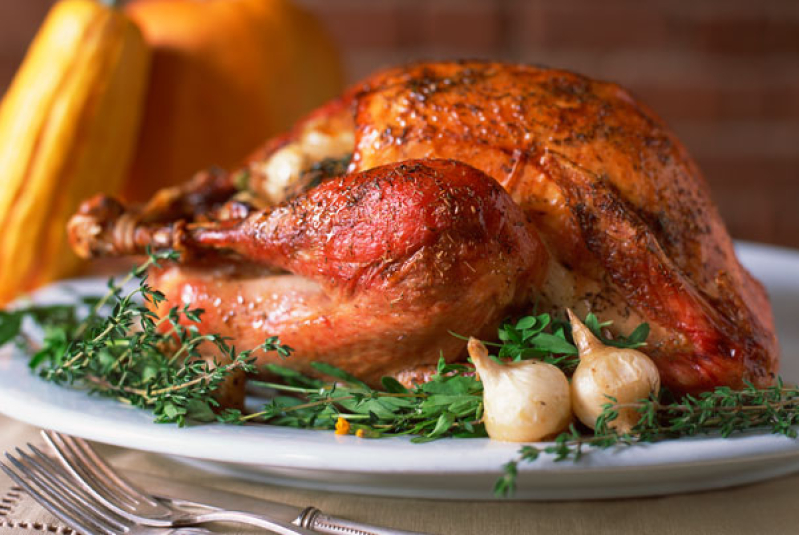
In most households across the United States, the signature entrée served over Thanksgiving dinner is a bird known as the turkey. Unlike a chicken or other forms of meat, though, turkey has its own rules for preparation, cooking and serving.
Before one can even begin to cook the turkey, it must be thawed out safely. According to Lauren Gordon of The Daily Meal, any turkey bird that is bought frozen must be given time to thaw.
"You cannot successfully cook a turkey if it isn't thawed thoroughly," Gordon wrote. "Allow it to thaw in the fridge three days before the big feast. If you find that the day before it is still too frozen, let it thaw in the sink for the entire day."
However, it is important not to rinse turkey or any raw poultry in the kitchen sink. According to an article on Food Safety News, getting rid of bacteria from the bird through this method is quite ineffective.
"Rinsing raw poultry isn't a very effective way to clean bacteria from your meal, but it is a great way to spread bacteria around your kitchen," Food Safety News wrote. "Washing poultry aerosolizes bacteria and splashes it around onto anything within several feet of your sink."
According to Food Safety News, the cooking process will kill off any bacteria. Also, keeping the turkey skin dry will make it crispy once cooked.
Once the turkey has been successfully thawed out and brined after a few days, it has to be tied up. According to Noelle Carter of the Los Angeles Times, "trussing" the bird plays a big role in the appearance of the cooked version.
"Trussing tightens the shape of the bird to give it that appealing shape: forcing the breast plate out, keeping the legs crossed at the ends," Carter wrote. "Without trussing, the bird would just lie there, limp and sloppy-looking."
Carter adds that butchers can truss a bird, but this step is quite easy to do at home.
Most American households cook their turkey in the oven. To ensure that the turkey is ready to serve and eat, Carter recommends using a meat thermometer to check for proper doneness.
"Turkey, like chicken, is done when a thermometer reaches at least 165 degrees," Carter wrote. "Slide the thermometer into the hip meat, in between the leg and breast; make sure the thermometer does not touch the bone, as this will give an artificially high reading (the bones heat faster than the meat)."
Carter added that if the turkey's joints twist easily, the meat is done cooking. Also, properly cooked turkey meat should feel firm when pressed, emitting clear juices.
If the meat is still pink, its color does not always indicate doneness according to Carter; this is especially true if the turkey meat is from a young bird. The only proper way to indicate doneness is measuring the turkey's temperature.
"While the meat should not be overly pink or "rubbery"-feeling (a good indication it still needs to cook), its meat might also remain a little pink even after cooking due to the hemoglobin in the tissue," Carter wrote.
As for cooking times, that will depend on the weight of the turkey. Gordon recommends that turkeys should be cooked without stuffing inside so the bird cooks faster in the oven.
Once the turkey is successfully cooked in the oven after a few hours, Carter recommends that the bird should be presented to people right out of the oven, and then taken back into the kitchen for carving.
Los Angeles Times food editor Russ Parsons has a few helpful tips in carving out the turkey.
"Use a carving knife that is stiff and sharp enough to cut through the bird's many joints," Parsons said. "Work on a cutting board that's large enough to hold everything comfortably, preferably one with a groove around the outside to catch the juices."
Parsons added that the turkey should be left to cool for about 30 minutes after removing from the oven; this allows the meat to reabsorb the juices. Aluminum foil can be used to cover the bird and keep it warm.
Parsons recommends cutting the turkey up first through the wings.
"Cut a deep slit through the base of the breast just above the wing's 'shoulder' joint," he said. "Flex the wing backward and cut through the joint. Hold the wing upright and cut straight down through the 'elbow' joint to divide the wing in half. Repeat with the other side."
Parsons then turns his attention to the turkey legs.
"Cut through the skin between the breast and the leg. Flex the leg down to pop free the 'hip' joint and then cut around it to separate the leg completely," he said. "Hold the leg upright by the drumstick and cut straight down through the 'knee' joint to divide the leg in half. Use a carving fork to pin the thigh to the carving board and cut away as much of the dark meat as you can in long clean slices. Repeat with the other side."
Finally, Parsons turns to carving the breast meat. He notes that the carving begins around the keel bone, known as the long, sharp bone that runs down the center.
"Cut straight down on one side until you feel the ribs underneath. Use the carving knife and fork to follow the bones, lifting the breast off in one piece," he said. "Now carve the breast in cross-wise slices. Repeat with the other side."
Once the turkey is served to guests alongside all the other Thanksgiving dishes, it's important not to leave them sitting at room temperatures for more than two hours, according to Food Safety News. All foods made with perishable ingredients such as meat, milk or eggs should be refrigerated promptly, including pumpkin pie.
"When storing leftovers, portion them out into shallow dishes so that they cool rapidly in the refrigerator or freezer," Food Safety News stated. "Cut breast meat into smaller pieces. Wings and legs can be left whole."
Food Safety News recommends thawing leftovers for consumption via the refrigerator, cold water or the microwave.
Following all these turkey tips will help ensure a happy, memorable, and safe Thanksgiving holiday on the food front.







